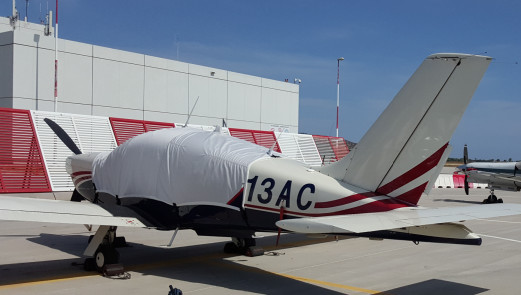A few weeks ago someone contacted me by snail mail having tracked me down through the CAA website. They represented a previous owner of my plane who had recently passed away, and his widow was selling his flying stuff for charity. Did I want to buy a Cambrai cover made for my plane, which he had owned some years ago. I said that if it was in good condition I’d certainly buy it. I then gave a donation to charity and acquired the cover. It’s very nice and it looks like this (from the Cambrai website. This is not my plane) "Cambrai cover on a third-party TB20 http://www.cambraicovers.com/socata_tb20_page.htm .
As you can see, the cover covers the cowling all the way to the front of the plane, just behind the spinner. My questions:
1) Am I risking damaging the plane’s paint / engine if I cover the cowling when the engine is still very hot? Will there be a build-up of condensation?
2)The cover is canvas and has no protection. Do people know if it will scorch if I put it on as soon as the plane has landed?
Answers much appreciated.
Thanks
Howard
Been using them for years and never had a problem with a hot engine and fitting straight after flight.
What is a problem is people leaving them on the ground / dragging them around so they collect grit and dirt and then that is put onto the aircraft, equally if the aircraft or cover is very wet when you put them on it can trap moisture in. Best thing is to be really pedantic about removing and folding carefully and storing in a dry box when not fitted.
Ps try to put them on single handed in a decent wind is a comedy routine all on its own!
Many thanks Balliol. Very helpful.
Howard
I echo all above, except that I would definitely not cover up the cowling holes if the engine is hot. I have cowling plugs but never put them in until the engine (the bits you can touch via the front holes) is down the hand-holding temperature. It prob99 won’t do any harm if it is at running temp but eventually it is bound to bugger up the upper cowling which is only standard fibreglass, and the baffle seals, etc.
And Socata are saying they have stopped manufacturing TB parts.
And yes NEVER let the cover touch the ground; you can say goodbye to the windows otherwise (they will be like the planes you did your PPL in  ). This is not always easy to ensure if you are on your own especially if it’s windy.
). This is not always easy to ensure if you are on your own especially if it’s windy.
The cover I have is the shortened lightweight reflective version, from Bruce’s Custom Covers, which doesn’t cover up the cowling front

My cover is getting old and attracts mildew more than in the past. Can anyone recommend a treatment?
When still in the UK I used to fly a lot with a chap who had one of those. We always put it on after having unloaded the airplane, didn’t appear to harm either a/c or cover in any way. What definitely is true is that this thing should never, ever get on the ground. We were always extremely careful in handling it. Applying it by yourself is a challenge, the more wind, the more amusing (to onlookers, not you!) this dance becomes….
Aveling wrote:
My cover is getting old and attracts mildew more than in the past. Can anyone recommend a treatment?
I would recommend searching online for your nearest equine rug wash company. Get it washed and reproofed for around £30 or so and it is amazing how much better it will look.
Never had an issue with putting our cover on straight after flight (although usually there are circumstances which means I’ve been stopped about 15 minutes before putting the cover back on).